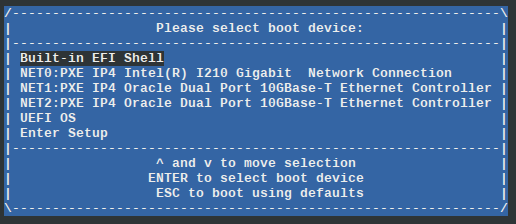Install Oracle Linux 6.9 OS Using Local or Remote Media
This procedure describes how to install the Oracle Linux 6.9 OS from local or remote media. The procedure assumes that you are booting the Oracle Linux installation media from one of the following sources:
-
Oracle Linux 6.9 DVD set
-
Oracle Linux 6.9 ISO DVD image (network repository)
If you are booting the installation media from a PXE environment, see Installing an Operating System Using PXE Network Boot for instructions.
-
Access the host console.
For instructions, see Selecting the Console Display.
-
Ensure that the installation media is available to boot.
For instructions, see Selecting the Boot Media Option.
-
Reset or power on the server.
For details, see Resetting or Powering on the Server.
Note - The next event occurs very quickly; therefore, be ready to press F8 to display the BBS Popup. Watch carefully for messages as they appear on the screen for a brief time. You might want to enlarge the size of your screen to eliminate scroll bars. -
On the BIOS screen, press F8 to specify a temporary boot device for the
Linux OS installation.
The Please Select Boot Device menu appears, listing the available boot devices.
Note - The Please Select Boot Device menu options might differ depending on the type of disk controller and other hardware, such as PCIe network cards, installed in your server.
-
On the Please Select Boot Device menu, select an option according to the
Linux OS media installation method you elected to use, and press Enter.
For example, to use the Oracle ILOM Remote System Console Plus application delivery, select [UEFI]USB:VIRTUAL:Remote Iso CDROM2.04.
- On the Booting Oracle Linux Server 6.9 boot screen, press Enter or allow the screen to time out.
- In the Disc Found dialog box, if this is the first time that you are doing an install from this media, consider selecting OK to test the media; otherwise, select Skip and press Enter.
- On the Oracle Linux 6 splash screen, scroll to the bottom, and click Next.
-
Follow the on-screen prompts to complete the Oracle Linux installation up
to the point where you create partitions.
For instructions on completing the Oracle Linux 6.9 installation up to the point where you create partitions, refer to the Oracle Linux 6 installation documentation at https://docs.oracle.com/cd/E37670_01/.
-
To create partitions, for each mount point, use the following file system
type and size.
Mount PointFile System TypeSize (MB)/boot/efiEFI System Partition200/ext420000Noneswap16384
-
Format the disk. To recover and reformat the disk without aborting the
install, click the keyboard Back button on the install screen several times
to return to the initial Oracle Linux splash screen and perform these
steps:
- To start the recovery shell, type Ctrl+Alt+F2.
-
To reformat the disk in GPT format or MBR format for this
installation, enter the following shell commands:
anaconda root@localhost /]# parted /dev/sdb GNU Parted 2.1 Using /dev/sda Welcome to GNU Parted! Type ???help' to view a list of commands. (parted) p Model: HITACHI H101860SFSUN600G (scsi) Disk /dev/sda: 600GB Sector size (logical/physical): 512B/512B Partition Table: msdos (or gpt for Legacy BIOS Boot Mode) Number Start End Size Type File system Flags 1 1049kB 21.5GB 21.5GB primary ext2 (parted) mklabel New disk label type? gpt (or msdos for Legacy BIOS Boot Mode) Warning: The existing disk label on /dev/sda will be destroyed and all data will be lost. Do you want to continue? Yes/No? yes (parted) p Model: HITACHI H101860SFSUN600G (scsi) Disk /dev/sda: 600GB Sector size (logical/physical): 512B/512B Partition Table: gpt Number Start End Size File system Name Flags (parted) g Information: You may need to update /etc/fstab. anaconda root@localhost /]#
- Press Ctrl+Alt+F6 to return to the graphical installation screen and continue the installation from the point of creating a partition (go to Step 10).
Note - In most cases, the values that you entered for this installation were saved, so you do not have to reenter them. - On the Install boot loader screen, select Install boot loader on /dev/sdb1, and click Next.
- On the Select Server screen, for the purposes of this sample installation, accept the Basic Server default option and click Next.
- After the installation completes, reboot the installation.
- Press F2 to access the BIOS Setup Utility so that you can set the server to boot from the operating system you just installed.
- Verify that the boot entry name you created (in this case, [Oracle Linux]) is listed as the first option in the UEFI Boot Option Priority field.
- Press F10 to exit the BIOS Setup Utility and reboot the installation.
- Press any key to display the GNU GRUB menu.
- Select Oracle Linux Server Red Hat Compatible Kernel (2.6.32-696.el6.x86_64) and press Enter.
-
Log in to Linux and perform these steps:
- Configure the network connection.
- Verify that the Linux Internet connection is active.
- Confirm that the UEK entry appears in: /etc/yum.repos.d/public-yum-ol6.repo
- Update to Oracle Unbreakable Kernel Release 4 by running yum update kernel-uek or yum update.
- When the update is complete, reboot the server with the reboot command to start the server with the new Oracle Unbreakable Enterprise Kernel.